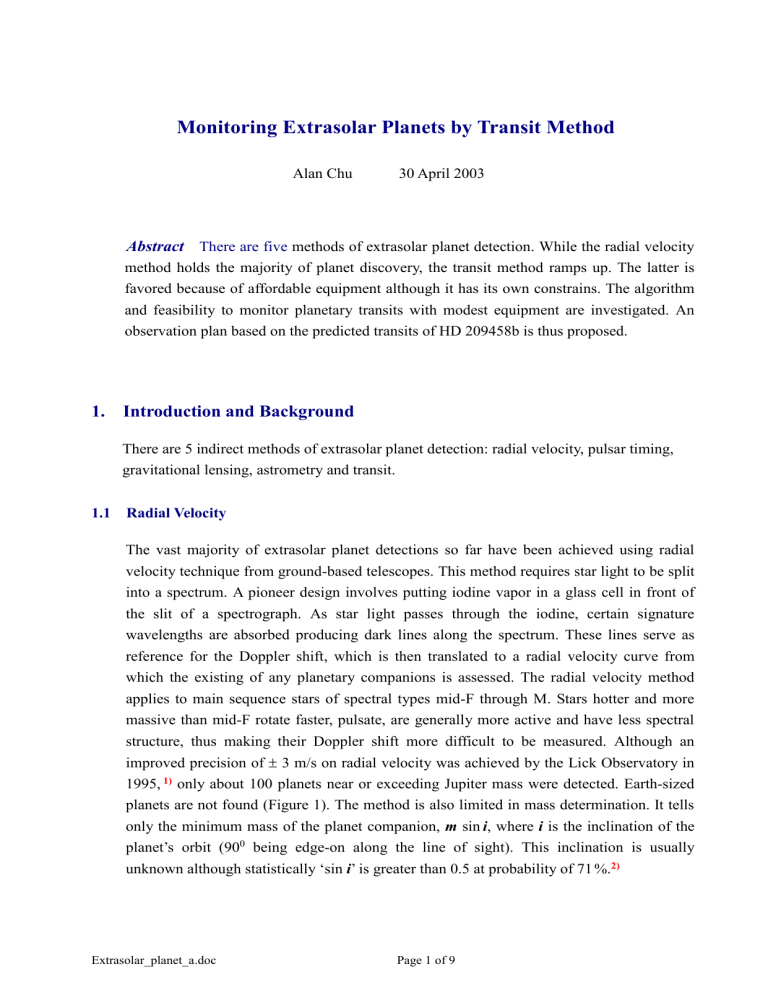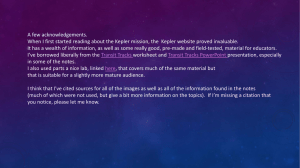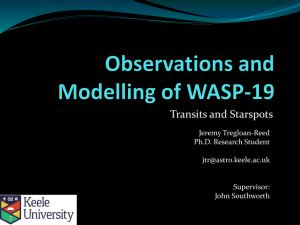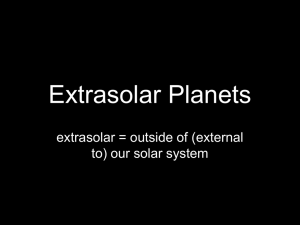Method:

Monitoring Extrasolar Planets by Transit Method
Alan Chu 30 April 2003
Abstract
There are five methods of extrasolar planet detection. While the radial velocity method holds the majority of planet discovery, the transit method ramps up. The latter is favored because of affordable equipment although it has its own constrains. The algorithm and feasibility to monitor planetary transits with modest equipment are investigated. An observation plan based on the predicted transits of HD 209458b is thus proposed.
1. Introduction and Background
There are 5 indirect methods of extrasolar planet detection: radial velocity, pulsar timing, gravitational lensing, astrometry and transit.
1.1
Radial Velocity
The vast majority of extrasolar planet detections so far have been achieved using radial velocity technique from ground-based telescopes. This method requires star light to be split into a spectrum. A pioneer design involves putting iodine vapor in a glass cell in front of the slit of a spectrograph. As star light passes through the iodine, certain signature wavelengths are absorbed producing dark lines along the spectrum. These lines serve as reference for the Doppler shift, which is then translated to a radial velocity curve from which the existing of any planetary companions is assessed. The radial velocity method applies to main sequence stars of spectral types mid-F through M. Stars hotter and more massive than mid-F rotate faster, pulsate, are generally more active and have less spectral structure, thus making their Doppler shift more difficult to be measured. Although an improved precision of
3 m/s on radial velocity was achieved by the Lick Observatory in
1995, 1) only about 100 planets near or exceeding Jupiter mass were detected. Earth-sized planets are not found (Figure 1). The method is also limited in mass determination. It tells only the minimum mass of the planet companion, m sin i , where i is the inclination of the planet’s orbit (90
0
being edge-on along the line of sight). This inclination is usually unknown although statistically ‘sin i
’ is greater than 0.5 at probability of 71
%.
2)
Extrasolar_planet_a.doc Page 1 of 9
Figure 1 - Mass Distribution of 97 securely known extrasolar planets. The dotted curve is best-fit by d (N) / d ( m )
m
0 .
7 for masses less than 8 M
Jup
. The lowest m sin i is 0 .
12 M
JUP
.
1.2 Pulsar Timing
Earth-mass and even smaller planets orbiting a pulsar are detected by measuring the periodic variation in the pulse arrival time. Most pulsars are created in supernova explosions by the collapse of the core of a supergiant star. It is thought that any planets found around pulsars are likely to have formed after the supernova, as any planets in the system before the explosion would likely be destroyed. So far 4 planets have been reported orbiting pulsars ( PSR 0329+54, 1257+12, 1620-26, 1829-10 ) but not all of them confirmed. 3)
1.3 Gravitational Lensing
Gravitational lensing occurs when a background object’s light is bent due to the gravity of the foreground object. A light curve from a stellar lensing is generally smooth, so when a companion planet of sufficient brightness happens to move behind the ‘lens’, a transient perturbance in the light curve results. This method can detect planets at distance up to about
5 kpc.
However a lensing event seldom repeats. This makes the method less attractive. No planet has been found by gravitational lensing.
1.4 Astrometry
It relies on very precise measurement of a star’s position as it is perturbed by an orbiting planet. The two 10-m Keck Telescopes, which are 85-m apart, have been combined as an optical interferometer to provide an astrometric resolution of 0.02 mas, leading to a minimum detectable mass of 0.2 M
JUP
at 1 AU orbit for a solar-mass star at 10 pc.
The limitations of this method are the distance to the star and variations in the position of the photometric centre due to star spots. So far no planet has been discovered using
Astrometry. The method is more rewarding in the mass determination of known planets,
Extrasolar_planet_a.doc Page 2 of 9
such as the planet orbiting the red dwarf Gliese 876.
4) A challenging development is the
TPF (Terrestrial Planet Finder). It is designed to use four space telescopes located at baseline longer than one kilometer, thereby improving its resolution. The TPF is scheduled to launch in the next decade.
1.5 Transit
This method measures the drop of stellar flux when a planet companion happens to transit in front of a star. The HD209458b in Pegasus, originally found with the radial velocity method in 1999, was the first planet observed to have transits. During its 3-hour transit, a flux drop of 1.6% or the equivalent change of 0.02 magnitude was measured from the host star. So far only few planets, including the recent discovered OGLE-TR-56b 5) , have been confirmed with transits.
The method is limited by stellar variability on the time scale of a transit. It can detect planetary size to about half that of Earth at 1 AU orbit. Planets with orbital periods greater than one year are not readily detectable, since their chance of being aligned along the line of sight to the star becomes very small. A planetary census based on the transit method will be performed by the Kepler Mission. It is a spaceborne wide-field telescope scheduled to launch in 2007, and is designed to detect simultaneously planetary transits of thousands of stars.
The common problem of all current methods is in telling what exactly the detected objects are --- giant planets, brown dwarf, dim red-dwarf, all of which have about the same physical size. In addition, gazing eclipses among normal binary stars can mimic the transit results. Therefore, planetary search methods need to counter-check each other if suspicion rises. Generally the radial velocity method remains as the ultimate ‘gate’ to see what’s actually going on.
This paper investigates the key elements of the transit method and the feasibility to apply it using a commercial-grade telescope and CCD detector that I have. An observational plan is then proposed to monitor the light curve of known planet-bearing stars.
Extrasolar_planet_a.doc Page 3 of 9
2. Why the transit method is favored ?
It is favored because transits can be studied within my budget of equipment and observational timeframes. The search methods of radial velocity, gravitational lensing, pulsar timing and astrometry call for million dollars of sophisticated equipment, involving a great deal of pooled expertise. With transit method, modest equipment similar to variable star observations can be applied, typically a ‘backyard’ telescope with small CCD chip as detector. According to the almanac of planets, most transit events, once detected, are repeatable; I can schedule repeatable observation sessions within a semester’s timeframe. Another challenge is that my observation results can be compared with the surveyed data in the professional field, or shared through the amateur website www.transitsearch.org
.
The repeatability of transits gives also the opportunity to speculate the planet’s surface environment in the future with improved instrumentation - one day it may be possible to examine a planet's atmosphere (by spectroscopy of absorption lines from its atmosphere while it is transiting) and check it for indicators of life - such as the presence of free oxygen in the atmosphere.
3. What are the expected constrains ?
The greatest constrain comes from the resolution of the photometric detector which measures transit depth in the stellar light curve. The transit depth or change in brightness is equal to the ratio of the area of the planet to the area of the star, i.e. Transit Depth = ( r / R
*
) 2 where r and R
*
are the radius of the planet and star respectively.
Assuming a Jupiter-size planet orbiting Sun-like star of radius 10 times larger, we have transit depth
1 % or stellar magnitude change of
2.5 log (1 – 1% )
0.01.
Star
HD209458
Figure 2 – A planetary transit light curve produced from HST
This small change is no problem to the Hubble Space Telescope (Figure 2) but is quite demanding to the modest ST-7E CCD camera I have. There are reports on the ST-7E which can achieve detection at one-sigma error of 0.003 ~ 0.007 magnitude, if operated in the differential photometry mode.
6) The success of distinguishing transits then relies on how the camera is cooled and trimmed for minimal uncertainty.
A second constrain comes from the atmosphere of the planet being detected. For planets in orbits very close to their stars, the radiation from the star actually expands the atmosphere of the planet and increases its radius. This increased radius is good news for transit hunters but creates an uncertainty in assessing r in the transit light curve.
Extrasolar_planet_a.doc Page 4 of 9
Fortunately, the planned observation does not require a telescope of big aperture, since candidates of fairly bright stars (magnitude < 9) are monitored. A 10-inch telescope at f/6 or faster focal ratio and fitted with ST-7E is expected to detect transit depth through careful data reduction.
4.
Which are the planet candidates ?
Table 1 is a shortlist of candidates intended for transit observation in Summer-Autumn seasons in my city at latitude 22
0
N. They are sorted with the following criteria:
The stellar magnitude is limited to 9, in order to secure a manageable CCD S/N ratio.
The planet orbital period is under 20 days so that transit depth, if any, can be repeatedly measured within schedule.
The transit probability, defined by stellar radius / planet orbital axis, is above 4 %.
The altitude of star at observation time can reach above 40 0 , in order to minimize the effect of light pollution around my site and atmospheric scintillation.
Star
Table 1 - Planet transit candidates with periods shorter than 20 days & transit probability > 4 %
Apparent
Magnitude
R.A.
(hr:min)
DEC
(deg:min)
Spectral Stellar Radius
Type (Sun = 1)
Planet Mass
(Jupiter = 1)
Period
(days) a
(AU) e
HD187123
HD209458
HD168746
HD195019
7.83
7.65
7.95
6.87
19:47
22:03
18:22
20:28
+34:25
+18:54
-11:55
+18:46
G5
F8
G5
G3 IV
1.15
1.15
1.07
1.38
0.54
0.63
0.24
3.50
3.097 0.042 0.01
6.400 0.066 0.00
18.20 0.136 0.02
Transit
Probability
12.4%
3.524 0.047 0.02 11.4% #
7.3%
4.4%
HD130322 8.03 14:48 -00:17 K0 III 0.83 1.15 10.72 0.092 0.05 4.1%
Planet Mass = m sin i a = Orbit semi-major axis e = orbital eccentricity # Transits are securely known.
There are two stars known to give planetary transits: HD209458 and OGLE-TR-56. The latter is excluded from Table 1 because its magnitude is 15.3. HD209458 will be my pilot object while the rest of stars experimented by trial and error.
5. How to predict transit events ?
Transit events (ingress, egress) can be predicted from T
0
(epoch of transit centre), P (orbital period) and other minor factors such as the radii of the planet and the star. For instance,
HD209458 gives T
0
= HJD 2452223.896173
0.000086 and P = 3.5247545
0.0000044 days based on the results by Schultz et al, 2003. 7) The HJD (Heliocentric Julian Date) refers to the solar centre, so there is a maximum deviation of
8 minutes (time for light traveling 1 AU) from the prediction for an observer on Earth. This deviation is considered insignificant in scheduling.
Extrasolar_planet_a.doc Page 5 of 9
A rolling list of predicted transits is also given in www.transitsearch.org
. There are 43 transit events between June and October 2003 for HD209458; about 1/3 of them are supposed favorable for observation. The planned observation will be scheduled according to this list.
6. How observed results are interpreted ?
Most likely, the transit is obscure in the pool of CCD raw images unless the data are carefully reduced (calibrated by taking many bias, dark and flat-field frames and averaging them to produce master bias, master dark and master flat-fields). Suppose the transit depth becomes obvious in the light curve after data reduction, Figure 3.
Let P = observed period between successive transits
(or obtained from almanac), unit in years
L a = semi-major axis of the planet’s orbit in AU
M
*
= stellar mass in M
SUN
R
*
= stellar radius in AU m = planet mass
T
F r = planet radius
The following analysis apply.
Figure 3 - The light curve of planetary transit
after data reduction.
F is the transit depth.
The planet orbital size is calculated from the Kepler’s third law: a
3
= M
*
P
2
given the star
mass is checked from its spectral type, such as the data in Allen’s Astrophysical Quantities .
For transits across the centre of the stellar disk, the transit duration is determined by
T centre
= (P /
) (R
*
/ a) , or in reduced form:
T centre
= 13
(a) hours. Thus the planetary transit of HD 209458 (Table 1) will last no more than
T centre
3.0 hours. The transit duration does not tell us anything physically about the planet and hence it must be consistent for all transits of a given star-planet combination. If not, then one suspects that there are multiple planets in the system that are being detected or some other non-transit phenomena are taking place.
Transit depth (fractional change in stellar flux) is given by
F = ( r / R
*
) 2 , Figure 3. The planet radius can be calculated once
F is measured and R
*
is known from the star’s spectral type. However,
F is typically a small value and the light curve is not smooth.
Therefore the planet radius so obtained with modest equipment is likely a rough estimate.
There is a light curve model of transit addressed by Schultz et al.
7) which fits into the HST observation results. The model includes the stellar limb darkening effect besides the planet’s
Extrasolar_planet_a.doc Page 6 of 9
orbital inclination. Perhaps it helps me to plot the best-fit light curve from the pool of raw data.
7. How transit method supplements the radial velocity method ?
By combining the orbital information from the radial velocity method with the physical information obtained with the transit method, one can learn a tremendous amount. As mentioned earlier, the radial velocity method gives only the minimum planet mass ‘ m sin i ’. To calculate the true mass, the orbital inclination i (90 0 being edge on) must be known. This angle can be deduced from the transit duration as below.
Orbital velocity of the planet (for a circular orbit) v = 2
a / P
Length of transit chord across stellar disk (Figure 3) L = v (
T)
The values of transit chord and stellar diameter enable us to determine the angle i and finally the correct planet mass. As a case study on the star HD209458, its diameter = 1.59 x 10
6
km, the planet’s velocity = 5.2 x 10 5
km/hr, transit duration = 2.9 hrs. By deduction, the transit chord is
3.3 x 10 4 km off-set from the centre of the stellar disk; this yields i
85 0 . A transit often implies large value of i . Nevertheless, once the planet mass is securely known, other physical quantities such as the density and surface gravity can be calculated to build a model of the planet.
8. Prospect of the transit method
On the long term, wide-angle CCD cameras, by monitoring in parallel the light curves of thousands of stars, should find ‘hot Jupiter’ transits much faster than the radial velocity method.
Figure 4 is an estimate of planet detection thresholds for different methods including radial velocity, astrometry, transit and gravitational lens.
8) It can be seen that while the radial velocity hundreds of planet discoveries in the next 5 years. method still holds the most discoveries at present, the transit method (including WASP, STARE,
Kepler Mission, Eddington projects) has plenty of room to expand. Transits may ramp up
Figure 4 - Planet detection thresholds on the planet mass versus orbit radius for four methods including radial velocity ( ), astrometry ( ), transit ( ) and gravitational lensing ( ). The 9 solar system planets and 100 extrasolar planets (
) are also indicated.
Extrasolar_planet_a.doc Page 7 of 9
9. Putting pieces together
the proposal
Based on the above study, an observational plan is now consolidated below.
Objectives To measure and analyze the light curve of a star with planet transits.
Target Object Star HD 209458 of magnitude = 7.65 RA = 22h 03.3m DEC = +18 0 54’
(plus other candidates in Table 1)
Observing Site Taipo, Hong Kong at 114.2
0 E 22.4
0 N
Schedules HD 209458
Time of planet transit maximum (
JD (UT) HK Standard Time t ) Altitude of star at t
Favorable for observation ?
2452763.287 2003.05.04
2452770.337 2003.05.11
2452777.386 2003.05.18
2452784.436 2003.05.25
2452809.109 2003.06.18
2452816.159 2003.06.25
2452823.208 2003.07.03
2452830.258 2003.07.10
2452837.307 2003.07.17
2452844.357 2003.07.24
2452851.406 2003.07.31
2452861.981 2003.08.10
2452869.030 2003.08.17
2452876.080 2008.08.24
2452883.129 2003.08.31
2452890.179 2003.09.08
2452897.228 2003.09.15
2452904.278 2003.09.22
2452911.327 2003.09.29
2452936.000 2003.10.23
2452943.050 2003.10.30
2452950.099 2003.11.06
2452957.149 2003.11.13
02:53
04:05
05:16
06:27
22:37
23:48
00:59
02:11
03:22
04:33
05:45
19:31
20:43
21:54
23:05
00:17
01:28
02:39
03:51
20:00
21:11
22:23
23:34
23 0
45
0
68 0
85
0
6
0
28 0
yes (egress only) no (sunrise at 05:44) yes (ingress only) no (sunrise at 05:39) no (altitude too low) yes (egress only)
51
0
74 0
yes (egress only)
YES (near zenith)
81
0
59 0
YES (near zenith)
yes (ingress only)
36
0
11 0
yes (ingress only)
no (altitude too low)
33 0
56 0
yes (egress only)
yes (egress only)
79 0
76 0
53 0
YES (near zenith)
YES (near zenith)
yes (ingress only)
31
0
8 0
yes (ingress only)
no (altitude too low)
84
0
71 0
yes (egress only)
YES (near zenith)
48
0
25 0
yes (ingress only)
yes (ingress only)
Duration of planet transit
3.0 hrs
rising
sinking
Equipment
Telescope: Celestron 9.25-inch Schmidt-Cassegrain with f6.3 or f/3.3 focal reducer and ‘goto’ equatorial mount.
CCD camera: Santa Barbara ST-7E with V-filter, non-antiblooming
version for greater well-capacity.
Sky map: The Sky Astronomy Software, version 5 level 4.
Processing software: AIP4WIN, differential photometry mode.
9)
Image FOV 16.0 x 10.6 arcmin @ f/6.3 30.5 x 20.3 arcmin @ f/3.3
Sampling Consecutive (10~20) images in every 10 to 15-minute interval
Precision of Measurement
A transit depth less than 0.02 magnitude drop is typical. To reach the resolution criteria of 1/3 transit depth, it requires careful calibration by taking many bias, dark and flat-field frames and averaging them to produce master bias, master dark and master flat-fields for data reduction.
Careful experiment with exposure, choice of comparing stars and aperture size in photometry are also critical.
Report Within Nov 2003
Extrasolar_planet_a.doc Page 8 of 9
There are 5 chances to witness the full course of HD 209458 transits between July and October
2003, as marked by the bold YES in the above table. Other dates are suitable only for transit ingress or egress observations, yet they are good times to test the system errors so that the measurements in next sessions can reach better precision.
10. Summary
Figure 5 - A CCD image simulated with
The SKY Astronomy Software. North is up.
The FOV is 16 .
0 x 10 .
6 arcmin corresponding to the C9 .
25 telescope at f/6 .
3 + ST-7E camera . The target object is HD 209458.
‘Compare’ and ‘Check’ stars in differential photometry can be chosen from:
1. GSC1688:1716 mag 11.62
2. GSC1688:1766 mag 10.63
3. GSC1688:1864 mag 11.32
The transit method as additional means to detect extrasolar planets ramps up although it has its own constraints. Through the study of survey data in this field, a transit observation plan using modest equipment is proposed. The plan is for known stars rather than adding one candidate discovery to the current 100+ census of extrasolar planets. The same technique of transit observation can be scaled to study other objects such as short-period eclipsing binaries and asteroid rotation light curves. On the long term, the experience gained from the transit method can make significant scientific contributions.
11. References
1.
Butler, R.P., Marcy, G.W. 1996, “Attaining Doppler Precision of 3 m s -1 ”, PASP, 108, 500.
2.
Butler, R.P., Marcy, G.W. 1997, “Extrasolar Planets Detected by the Doppler Technique”, ASP Conference #134, p.128.
3.
Bell, G.H. 2001, “The Search for the Extrasolar Planets: A Brief History of the Search, the Findings and the Future
Implications” http://www.public.asu.edu/~sciref/exoplnt.htm
4.
S&T April 2003, p.21
5.
Konachi, Torres et al. 2003, “An extrasolar planet that transits the disk of its parent star”, Nature 421, 507K.
6.
Castellano, T., Laughlin. G. 2001, “The Discovery of Extrasolar Planets by Backyard Astronomers” http://www.transitsearch.org/detailedobservingprocedure.doc
7.
Schultz, A.B., G. Henry et al. 2003, “Monitoring the Planetary Transits of HD209458b”, ASP Conference Series, Vol.294
8.
Horne, K. 2003, “Status and Prospects of Planetary Transit Searches: Hot Jupiters Galore”, ASP Conference Series, V.294
9.
Berry & Burnell “The Handbook of Astronomical Image Processing” © 2000, p.241-267
Extrasolar_planet_a.doc Page 9 of 9









